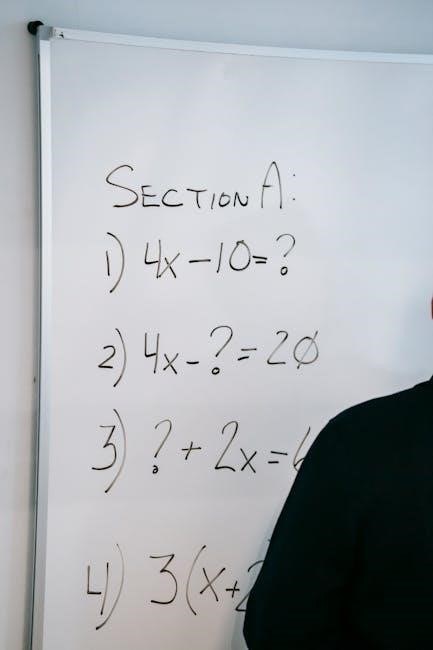Discover how stretching exercises can alleviate sciatica pain and improve mobility. This guide provides a comprehensive approach to managing symptoms through targeted stretches and exercises.
1.1 Overview of Sciatica and Its Symptoms
Sciatica refers to pain caused by irritation or compression of the sciatic nerve, which runs from the lower back down to the legs. Common symptoms include sharp or shooting pain in the back, buttocks, and legs, along with numbness, tingling, or weakness. Symptoms can vary in severity and often worsen with prolonged sitting or certain movements. Understanding these symptoms is key to effectively managing the condition and implementing appropriate stretching exercises for relief.

1.2 Importance of Stretching for Sciatica Relief
Stretching is a cornerstone of managing sciatica, as it targets tight muscles that compress the sciatic nerve. Regular stretching helps reduce pain, improve mobility, and prevent future episodes. By loosening the piriformis, hamstrings, and hip flexors, stretching alleviates nerve pressure and promotes healing. Consistent practice enhances flexibility, strengthens supporting muscles, and improves posture, reducing discomfort and enhancing overall well-being. Incorporating stretching into your routine is essential for long-term sciatica relief and maintaining an active lifestyle.

Understanding Sciatica
Sciatica is a condition causing pain along the sciatic nerve, often due to compression or irritation. It typically affects the lower back, buttocks, and legs, impacting mobility and comfort.
2.1 What Is Sciatica?
Sciatica is a condition characterized by pain radiating along the sciatic nerve, which runs from the lower back through the hips and down the legs. It occurs when the nerve is irritated or compressed, often due to a herniated disc, spinal stenosis, or piriformis syndrome. Sciatica is not a medical diagnosis but a symptom of an underlying issue. The pain can range from mild to severe and may be accompanied by numbness, tingling, or weakness. Understanding the cause is crucial for effective treatment, as it determines the appropriate interventions to alleviate symptoms and restore normal nerve function.
2.2 Common Causes of Sciatica
Sciatica is often caused by compression or irritation of the sciatic nerve, typically stemming from a herniated disc, degenerative disc disease, or spinal stenosis. Piriformis syndrome, where the piriformis muscle tightens and presses on the nerve, is another common cause. Spondylolisthesis, a condition where a vertebra slips out of place, can also contribute. Additionally, muscle imbalances, poor posture, or sudden injuries may lead to sciatica. Identifying the root cause is essential for developing an effective treatment plan, especially when incorporating stretching exercises to relieve symptoms and restore mobility.
2.3 Symptoms and Diagnosis
Sciatica symptoms often include sharp or dull pain radiating from the lower back to the buttocks, hips, and legs. Numbness, tingling, or burning sensations may accompany the pain. Weakness in the affected leg or foot is also common. Diagnosis typically involves a physical exam, review of medical history, and imaging tests like MRI or CT scans to identify nerve compression. Proper identification of symptoms is crucial for accurate diagnosis and effective treatment, ensuring that stretching exercises target the root cause of sciatica pain for optimal relief and recovery.

Benefits of Stretching for Sciatica
Stretching exercises for sciatica provide significant relief by loosening tight muscles, improving mobility, and reducing nerve compression. Regular stretching enhances flexibility and strengthens core muscles, promoting long-term pain management.
3.1 How Stretching Alleviates Sciatica Pain
Stretching exercises target tight muscles that compress the sciatic nerve, reducing pressure and pain. By improving blood flow and relieving muscle tension, stretching helps alleviate discomfort. Regular stretching can reduce inflammation, improve nerve function, and enhance mobility, providing long-term relief from sciatica symptoms. Gentle stretches, such as the piriformis stretch, specifically address muscles contributing to sciatic nerve compression, offering targeted pain relief and promoting healing. Consistent practice of these exercises can significantly reduce the intensity and frequency of sciatica pain, improving overall quality of life.
3.2 Improving Mobility and Flexibility
Stretching exercises enhance mobility by loosening tight muscles around the sciatic nerve, reducing stiffness and improving range of motion. Regular stretching increases flexibility, making daily activities easier and reducing discomfort. Exercises like the Cat-Cow stretch and Hamstring stretch target key areas, promoting fluid movement and reducing muscle rigidity. Improved mobility allows individuals to perform exercises and movements without exacerbating sciatica symptoms, fostering a more active and comfortable lifestyle; Consistent practice of these stretches helps maintain flexibility, preventing future limitations and enhancing overall physical function.
3.3 Strengthening Core and Supporting Muscles
Strengthening the core and supporting muscles is essential for sciatica relief, as it provides stability to the lower back and pelvis. Weak core muscles can lead to poor posture and increased pressure on the sciatic nerve. Exercises like planks, bird-dog, and glute bridges target these areas, improving spinal alignment and reducing strain. Strengthening the abdominals and glutes helps create a supportive framework, preventing muscle imbalances that exacerbate sciatica. By building strength, individuals can better manage daily activities and reduce the likelihood of recurring pain.

Best Stretching Exercises for Sciatica
Targeted stretches like the piriformis, hamstring, and cat-cow stretches help relieve sciatica pain by loosening tight muscles and improving flexibility in the lower back and hips.
4.1 Piriformis Stretch
The piriformis stretch targets the piriformis muscle, which often compresses the sciatic nerve. Lie on your back, cross the affected leg over the other knee, and gently pull the unaffected leg toward your chest until a stretch is felt. Hold for 20-30 seconds and repeat 2-3 times. This stretch helps relieve tension in the piriformis muscle, reducing sciatica pain and improving hip mobility. For optimal results, perform this stretch daily and combine it with other exercises for comprehensive relief. Always ensure proper form to avoid further discomfort.
4.2 Cat-Cow Stretch
The Cat-Cow Stretch is a gentle exercise that improves spinal flexibility and relieves tension in the lower back, which can contribute to sciatica pain. Start on your hands and knees. Inhale as you arch your back, lifting your head and tailbone (Cow Pose). Exhale as you round your spine, tucking your chin and pelvis (Cat Pose). Repeat for 10-15 repetitions. This stretch promotes relaxation, improves posture, and reduces pressure on the sciatic nerve. Perform it slowly and smoothly to maximize benefits and avoid discomfort. Regular practice can enhance mobility and reduce stiffness in the spine and hips.

4.3 Hamstring Stretch
The Hamstring Stretch targets the muscles at the back of the thighs, which, when tight, can contribute to sciatica pain. Lie on your back, lift one leg toward the ceiling, and gently pull it toward your chest using a strap or towel. Hold for 20-30 seconds and repeat on the other side. This stretch can help reduce tension in the hamstrings, alleviate pressure on the sciatic nerve, and improve flexibility. Perform it slowly and avoid bouncing. Regular practice can lead to long-term relief from sciatica symptoms and enhanced lower body mobility. For best results, incorporate this stretch into your daily routine.
4.4 Seated Sciatic Nerve Stretch
The Seated Sciatic Nerve Stretch is a simple yet effective exercise for relieving sciatica pain. Sit on the floor with your legs extended straight. Loop a towel around the ball of one foot and gently pull back to create a stretch in the back of your leg. Hold for 20-30 seconds and switch sides. This stretch targets the sciatic nerve and surrounding muscles, helping to reduce tension and discomfort. Regular practice can enhance nerve mobility and provide lasting relief from sciatic discomfort. Perform this stretch slowly and avoid bouncing to maximize its benefits.
4.5 Standing Hip Extension Stretch
The Standing Hip Extension Stretch effectively targets the glutes and hip flexors, which often contribute to sciatica pain. Stand tall, hold onto a sturdy object for balance, and slowly lift one leg behind you, keeping it straight. Focus on squeezing your glutes at the top of the movement. Hold for 2-3 seconds, then lower your leg. Repeat on the other side. This stretch improves hip mobility, reduces muscle tightness, and alleviates pressure on the sciatic nerve. Perform 10-15 repetitions on each leg for optimal benefits. Regular practice can enhance flexibility and reduce sciatic discomfort.
4.6 Pigeon Pose
Pigeon Pose is a highly effective stretch for sciatica relief, targeting the piriformis muscle, which often compresses the sciatic nerve. Start on your hands and knees, then bring one knee forward, placing your ankle behind the other knee. Lower your hips to the ground, extending the other leg behind you. Hold for 20-30 seconds, breathing deeply to release tension. This stretch helps relieve pressure on the sciatic nerve, improves hip flexibility, and reduces lower back discomfort. Perform on both sides to ensure balanced relief and enhanced mobility. Regular practice can significantly ease sciatica symptoms.
4.7 Hip Flexor Stretch
The hip flexor stretch targets the iliopsoas muscle, which can contribute to sciatica when tight. Kneel on one knee with the other foot in front, keeping your spine neutral. Push your hips forward until a stretch is felt in the front of your hip. Hold for 20-30 seconds and switch sides. This stretch improves hip mobility, reduces lower back strain, and alleviates sciatic nerve pressure. Regular practice can help prevent tightness and enhance overall flexibility, making it an essential part of a sciatica relief routine. Perform it gently to avoid discomfort.
4.8 Lower Back Stretches
Lower back stretches are crucial for relieving sciatica, as tight muscles in this area can compress the sciatic nerve. The kneeling cat-cow stretch and seated lumbar flexion are effective. Start on hands and knees, arching your back (cow pose) and then rounding it (cat pose). Hold each position for 5 seconds, repeating 10 times. For seated lumbar flexion, sit upright, knees bent, and gently lean forward, stretching your lower back. These exercises improve spinal flexibility, reduce tension, and promote healing, making them essential for managing sciatica symptoms effectively and enhancing overall back health. Consistency is key for lasting relief.

Exercise Routine for Sciatica Relief
A well-structured routine combining stretching, strengthening, and relaxation techniques can significantly alleviate sciatica symptoms. Regular practice improves mobility, reduces pain, and enhances overall spinal health.
5.1 Warm-Up Exercises
Starting with gentle warm-up exercises is crucial to prepare the muscles and joints for more intense stretching. Light movements like leg swings, arm circles, and torso twists increase blood flow and flexibility. These exercises help reduce stiffness and minimize the risk of injury during the main workout. Incorporating dynamic stretches, such as high knees or hip openers, can further activate the muscles, particularly around the lower back and hips, which are often affected by sciatica. A proper warm-up sets the foundation for a safe and effective exercise routine.
5;2 Core Strengthening Exercises
Strengthening the core muscles is essential for stabilizing the spine and reducing sciatica-related discomfort. Exercises like planks, bird-dog, and pelvic tilts target the abdominal and back muscles, improving posture and reducing pressure on the sciatic nerve. Gentle core work helps build endurance without overstraining. Incorporate modified versions of these exercises to suit your fitness level, focusing on controlled movements. A strong core provides better support for the lower back, promoting long-term relief from sciatica symptoms and enhancing overall mobility.
5.3 Cool-Down and Relaxation Techniques
A proper cool-down after exercising is crucial for sciatica relief. Gentle stretches, deep breathing, and relaxation exercises help reduce muscle tension and promote blood flow. Techniques like yoga poses, foam rolling, or light massage can soothe tight muscles. Incorporate activities like walking or swimming to gradually lower your heart rate. Mindfulness practices, such as guided relaxation or meditation, can reduce stress and enhance recovery. Ending your routine with these calming methods ensures your body transitions smoothly from activity to rest, supporting long-term sciatica management and overall well-being.

Safety Considerations
Always avoid stretches that worsen symptoms and maintain proper form to prevent injury. Incorporate rest periods and consult a healthcare professional to tailor your routine safely.
6.1 When to Avoid Certain Stretches
Some stretches should be avoided if they exacerbate symptoms or worsen pain. Avoid deep forward bends or aggressive twists during acute sciatica flare-ups. Stretches that cause numbness, tingling, or shooting pain should be discontinued immediately. Additionally, steer clear of stretches that place direct pressure on the sciatic nerve, especially if inflammation is present. It’s crucial to modify or avoid stretches that trigger discomfort and consult a healthcare professional for personalized guidance. Proper form and symptom awareness are key to safely engaging in stretching exercises for sciatica relief.
6.2 Importance of Proper Form
Proper form is essential when performing stretching exercises for sciatica to ensure effectiveness and prevent further injury. Incorrect technique can strain muscles or worsen nerve compression, leading to increased pain. Pay attention to body alignment and avoid bouncing or forcing beyond a comfortable range. Maintaining controlled, gentle movements helps target the correct muscles without aggravating the sciatic nerve. Consistency and precision in form maximize the benefits of stretching while minimizing the risk of complications. Always consult a professional to learn proper techniques tailored to your condition.
6.3 Role of Rest and Recovery
Rest and recovery are crucial components of managing sciatica alongside stretching exercises. Allowing the body time to heal prevents overexertion and further inflammation. While stretching is beneficial, excessive activity can exacerbate symptoms. Incorporating periods of rest helps reduce muscle tension and promotes healing. It’s important to balance activity with recovery to avoid aggravating the condition. Proper rest supports the body’s natural repair processes, complementing the benefits of stretching and exercise. This balance is key to achieving long-term relief and preventing recurring sciatica pain.

Additional Tips for Managing Sciatica
Incorporate physical therapy, maintain proper posture, and explore relaxation techniques to complement stretching exercises for sciatica relief. These strategies enhance overall well-being and pain management effectively.
7.1 Incorporating Physical Therapy
Incorporating physical therapy into your routine can significantly enhance sciatica management. A trained therapist can design personalized programs combining stretching, strengthening, and stability exercises. Techniques like glute bridges, nerve glides, and core work target specific areas to reduce pain and improve mobility. Physical therapy also addresses underlying issues, such as muscle imbalances or poor posture, contributing to sciatica. Many exercises can be done at home, but professional guidance ensures proper form and effectiveness. Regular sessions can lead to long-term relief and prevent future flare-ups, making it a valuable complement to daily stretching routines.
7.2 Using Heat or Ice Therapy
Heat or ice therapy can provide immediate relief from sciatica pain. Applying a warm compress or taking a warm bath relaxes tight muscles and improves blood flow. Ice therapy reduces inflammation and numbs the area, alleviating sharp pain. Alternate between heat and ice, starting with ice for acute pain and switching to heat for chronic stiffness. Always wrap ice in a cloth to avoid skin damage and limit sessions to 15-20 minutes. Combining therapy with stretching exercises enhances pain relief and accelerates recovery, making it a simple yet effective addition to your sciatica management routine.
7.3 Maintaining Good Posture
Maintaining good posture is essential for managing sciatica pain. Poor posture can exacerbate nerve compression, worsening discomfort. When sitting, ensure your chair supports your lower back, with feet flat on the floor. Avoid slouching or crossing legs, as this can tighten the piriformis muscle. While standing, keep weight evenly distributed and engage core muscles. Sleeping on a supportive mattress and using a pillow between the knees can also reduce pressure on the sciatic nerve. Consistent awareness of posture helps prevent muscle imbalances and supports long-term pain relief, complementing stretching exercises for optimal sciatica management.
Stretching exercises are a powerful tool for managing sciatica, offering relief and improving mobility. Consistent practice, combined with proper posture, can lead to lasting comfort and reduced pain.
8.1 Final Thoughts on Stretching for Sciatica
Stretching exercises are a cornerstone in managing sciatica, providing effective relief and enhancing mobility. Regular practice can significantly reduce pain and improve quality of life. Consistency is key to long-term benefits, helping to alleviate discomfort and strengthen supportive muscles. By incorporating these exercises into daily routines, individuals can take proactive steps toward managing sciatica and maintaining spinal health. Always consult a healthcare professional before starting new exercises to ensure they are tailored to specific needs and conditions;
8;2 Encouragement to Continue a Stretching Routine
Staying committed to a stretching routine is essential for long-term sciatica relief. While it may feel challenging at first, consistency yields significant benefits, including reduced pain and improved mobility. Celebrate small progress and remind yourself of the positive impact on your overall well-being. Over time, these exercises become a empowering habit, helping you regain control over your body. Motivate yourself to keep going, knowing that each stretch brings you closer to a pain-free life. Download our PDF guide for a structured plan to stay on track and achieve lasting relief.

Downloadable Sciatica Stretching Guide
Access our comprehensive PDF guide featuring detailed stretches, routines, and tips to alleviate sciatica pain. Download now and start your journey toward relief and improved flexibility.
9.1 How to Access the PDF Guide
To access the Sciatica Stretching Guide PDF, visit the provided link or click the download button on the page. Follow the simple instructions to save the guide to your device. This comprehensive resource includes detailed stretches, diagrams, and routines tailored to alleviate sciatica pain. Print or digital options are available for convenience. Download now and begin your journey toward relief and improved flexibility with expert-recommended exercises;
9.2 What to Expect in the Guide
The Sciatica Stretching Guide PDF offers a detailed, easy-to-follow program designed to relieve sciatica pain. Inside, you’ll find a variety of stretches targeting key muscles like the piriformis, hamstrings, and hip flexors. Each exercise is accompanied by clear instructions, diagrams, and photos to ensure proper form. The guide also includes routines for different fitness levels, from gentle stretches for beginners to advanced movements for those seeking deeper relief. Additional tips on posture, core strengthening, and relaxation techniques are provided to enhance your recovery journey and improve overall mobility.






























